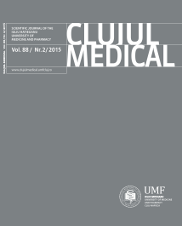THE INFLUENCE OF LASER RADIATION ON HUMAN OSTEOBLASTS CULTURED ON NANOSTRUCTURED COMPOSITE SUBSTRATES
DOI:
https://doi.org/10.15386/cjmed-433Keywords:
laser radiation, osteoblasts, nanostructures, composites, substratesAbstract
Background & Aims. Carbon-based nanomaterials such as carbon nanotubes, graphene oxide and graphene have been explored by researchers as well as the industry. Graphene is a new nanomaterial which has commercial and scientific advantages. Laser therapy has proven highly useful in biomedicine, with the use of different laser types and energies for distinct purposes. The low level laser therapy (LLLT) can have anti-inflammatory, analgesic and biostimulant effects. Recent research has shown that laser radiation has different effects on osteoblasts. The aim of this study was to identify the influence of laser radiation on human osteoblastic cells cultured on nanostructured composite substrates.
Materials and methods. Four types of substrates were created using colloidal suspensions of nanostructured composites in PBS at a concentration of 30 µg/ml. We used human osteoblasts isolated from patella bone pieces harvested during arthroplasty. Irradiation of osteoblasts cultured on nanostructured composite substrates was made with a semiconductor laser model BTL-10 having a wavelength of 830 nm. The proliferation activity of osteoblast cells was assessed using the MTT assay. After laser irradiation procedure the viability and proliferation of osteoblast cells were analyzed using fluorescein diacetate (FDA) staining.Results. The osteoblast cells viability and proliferation were evaluated with MTT assay at 30 minutes, 24 hours, 5 days and 10 days after laser irradiation. In the first 30 minutes there were no significant differences between the irradiated and non-irradiated cells. At 24 hours after laser irradiation procedure a significant increase of MTT values in case of irradiated osteoblasts cultivated on nanostructured hydroxyapatite, nanostructured hydroxyapatite with gold nanoparticles and 1.6% and 3.15% graphenes composites substrates was observed. A more marked proliferation rate was observed after 10 days of irradiation for irradiated osteoblasts seeded on nanostructured hydroxyapatite with gold nanoparticles and graphenes containing substrate. Using FDA staining we obtained very similar results with MTT test.
Conclusions. The association between the 830 nm laser irradiation of osteoblasts and their long-term cultivation of the nanostructured composite substrates induces the cell proliferation and differentiation and, therefore, it will be a useful alternative for bone regeneration therapy.
Downloads
Additional Files
Published
How to Cite
Issue
Section
License
The authors are required to transfer the copyright of the published paper to the journal. This is done by agreeing to sign the Copyright Assignment Form. Whenever the case, authors are also required to send permissions to reproduce material (such as illustrations) from the copyright holder.

The papers published in the journal are licensed under a Creative Commons Attribution-NonCommercial-NoDerivatives 4.0 International License.

